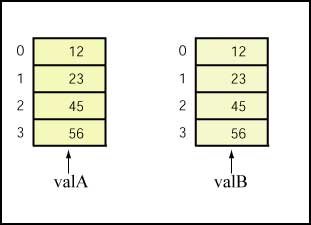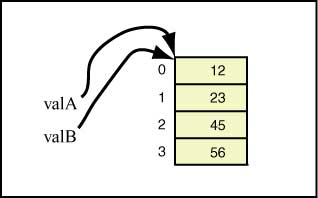public class ArrayEg4
{
public static void main ( String[] args )
{
int[] valA = { 12, 23, 45, 56 };
int[] valB = new int[4];
valB[ 0 ] = valA[ 0 ] ;
valB[ 1 ] = valA[ 1 ] ;
valB[ 2 ] = valA[ 2 ] ;
valB[ 3 ] = valA[ 3 ] ;
}
}


In this example, the int in cell 0 of valA
is copied to cell 0 of valB,
and so on.
valB[ 0 ] = valA[ 0 ] ;
This is just like an assignment statement
spot = source;
where both
variables are of primitive type int.
After the four assignment statements of the answer have executed,
each array contains the same values
in the same order:
Super Bug Alert: The following statement does not do the same thing:
valB = valA ;
Remember that arrays are objects. The statement above
copies the object reference in valA into the object
reference variable valB,
resulting in two ways to access the array object valA,
as seen in the second picture.
The object that valB previously referenced is now lost
(it has become garbage.)
valA and valB are now aliases for the same object.
The array object previously pointed to by valB is now garbage
(unless there is some other reference variable that points to it.)
Say that the following executes, resulting in the second picture above. What is printed out?
valB = valA; valA[2] = 999; System.out.println( valA[2] + " " + valB[2] );